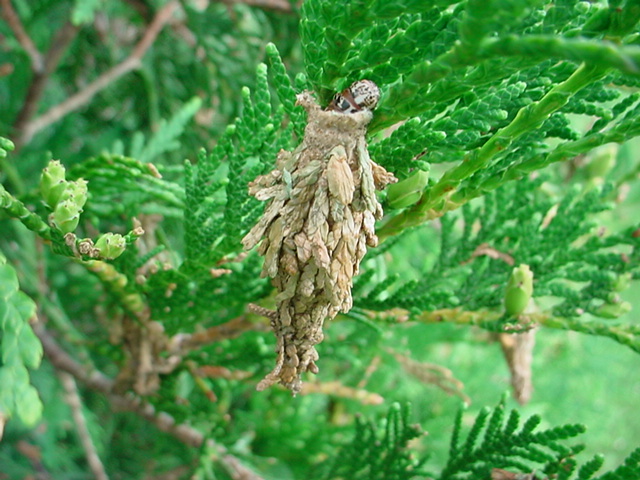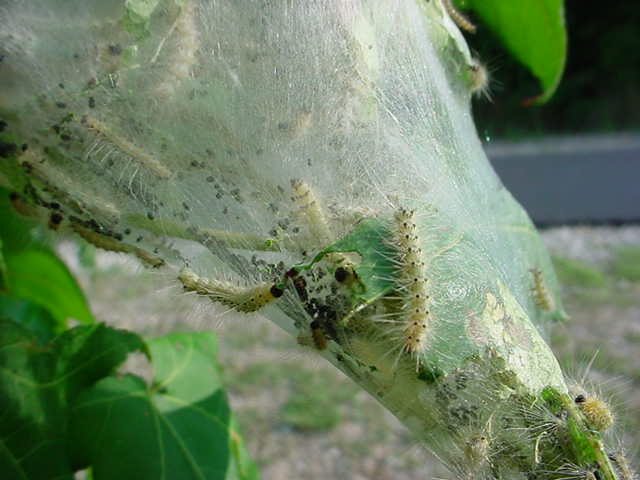Bagworms or Webworms – What’s the Difference?
Bagworms or webworms – is there a difference? Are both bad? Although it is common for the average homeowner to confuse the two based simply on the name, let’s explore the aspects of these pests, one camouflaged, and one that is more conspicuous. And, should we do anything about them?
Bagworms primarily affect evergreens. Bagworm-infested trees or shrubs have probably been infested since early June. Homeowners usually didn’t see them until now because they were small and because they used plant parts to disguise the silken bags they traveled around in.
Dr. Timothy Gibb, Purdue Extension Entomologist, said, “During July and August, bagworms may defoliate arborvitae, junipers, and other trees and shrubs.” He added, “Bagworms are caterpillars that live inside bags made of silken threads and plant material. They look like regular plant parts, so they are somewhat disguised from homeowners. The caterpillars crawl part way out of the bag to feed but retreat like a turtle into their shell if disturbed. The bag dangles like a Christmas ornament on a tree.”
Gibb said bagworms mature in late August or early September. At this time the bags are about 2 inches long and the caterpillars can no longer be killed by pesticides. The caterpillars pupate and then turn into mature adults. The winged males leave their bags, mate with females, and then the females lay eggs inside the bag. The females never leave their bags. He says each female can produce over 1000 bagworms. The eggs overwinter in the bag, and then next spring the young caterpillars hatch. They disburse and begin spinning their bag, and they start to feed.
Spring is the optimal time to use insecticides to control young bagworms. But, now we’re into August. I had a personal conversation with Dr. Cliff Sadof, Purdue Extension Entomologist, about this subject, and he said, “The question to be asking now is, ‘Are they still feeding?’ If they are not feeding, pesticides will have no effect on this pest.” He said that is why in the late season, hand-picking is almost always the preferred method of control.

Above: Bagworm on arborvitae. Note caterpillar's head poking out the top to feed. Photo by John E. Woodmansee
Sadof authored an article for the Purdue Landscape Report in which he described fall webworm or mimosa webworm as the likely web-forming insects, the second insects that we’ll discuss.
Many people confuse bagworms with webworms mainly because the names sound roughly similar. Fall webworms form large cobwebs that are easily visible in deciduous trees, those that lose their leaves each fall. Mimosa webworms also form cobwebs but are limited to honeylocust and mimosa trees.
Sadof said that neither pest can outright kill trees, but they are unsightly, especially at the end of the summer when substantial portions of the tree are disfigured.
The damage that is typically seen is a tight webbing on branch tips. Inside, you see caterpillars crawling around, including fecal pellets that get trapped in the webbing rather than falling to the ground.
Sadof said that fall webworm attacks a wide range of deciduous trees including flowering fruit trees, black walnuts, elm, hickory, and bald cypress. “They are most common in suburban areas, roadsides, and forest edges that lack the predators and parasites the webworms encounter in the forest.” Caterpillars are yellowish-green with black spots and long white hairs, and up to 1.5 inches long.

Above: Fall webworm caterpillars. Photo by John E. Woodmansee
Sadof said that, unlike fall webworm, the mimosa webworm only attacks honeylocust and mimosa trees. “Leaves on the ends of branches become webbed together and turn brown as lime-green caterpillars skeletonize leaf tissue,” he said. “Heavily infested trees appear frosted brown.” These caterpillars are also much smaller than fall webworm, growing to only about 1 inch.
If you only have a few webs in your trees, one option is to simply prune them out and burn them. However, this tactic will not work in all cases, especially with heavily infested or larger trees. Sadof said that insecticides are not recommended in late summer because the damage has already been done, and it’s also difficult to penetrate the webs with the insecticides. He recommended that homeowners plan for treatment next year.
“Control of webworm caterpillars is best achieved if actions are taken before the trees become covered with webs,” he said. “By identifying trees that are heavily infested this year, you can target your efforts next spring before webbing becomes extensive.”
Find pesticide options in Sadof’s original article, “Oh What a Tangled Web They Weave!” at: https://www.purduelandscapereport.org/.
Also find Purdue Extension publications on Bagworms, Fall Webworm, and Mimosa Webworm, including insecticide options, at the Purdue Education Store, www.edustore.purdue.edu.